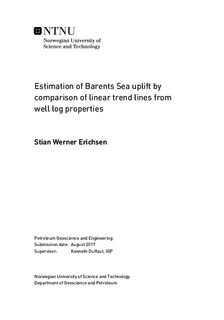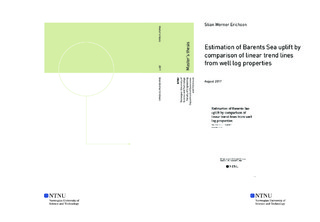| dc.description.abstract | Linear trends of measured well log properties have been compared in this thesis, to see if uplift in the Barents Sea can be estimated. Reference trends from areas that have not been uplifted, wells 15/9-6, 34/7-1, 34/7-5 and 6608/10-3, have been compared to linear trends from areas that have been uplifted, wells 7216/11-1 S, 7117/9-1, 7120/5-1 and 7121/4-1, from the Barents Sea.
The well log properties used are Vp, Vs, Vp/Vs, Rhob, Rdeep and porosity. All these properties can be used to get uplift estimates, except for Rdeep, which can only be used to say something about if the are has been uplifted or not. Rdeep cannot be used to get any uplift estimate values.
When comparing two trend lines, they should ideally have the same lithology, porosity and pore pressure. They should also be as parallel as possible. If these criteria are not met, the uplift estimates will be incorrect, and span over a very large range of values.
Wells located to the west in the Barents Sea, 7216/11-1 S and 7117/9-1, show no uplift, which is as expected. The two other wells show uplift from 600 to 1500m, which is a range of values that are realistic. This study shows that the method is working, if the mentioned criteria are met | |

